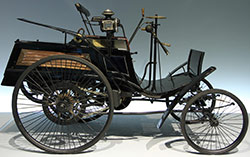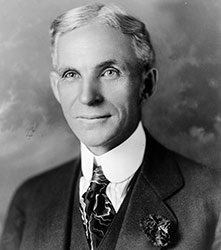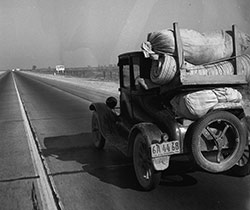In 1876, a German engineer named Nikolaus Otto built a new kind of engine.1 The internal combustion engine didn't need a separate, heavy boiler to burn fuel, as the steam engine did. It burned the fuel inside the engine itself.
Engineers could build internal combustion engines that were much lighter and smaller than steam engines. And inventors could fit the new engines to smaller vehicles ... like cars.
In 1885, the inventor Karl Benz showed a vehicle using the new type of engine in Germany. The "Motorwagen" had three wheels and could seat two people.2

Benz hoped that rich people would buy the Motorwagen, but they didn't think it was reliable. Then his wife Bertha had an idea. She drove the Motorwagen over sixty miles with their two sons on board. The news of the trip spread across Germany, and the Motorwagen became famous.
Many think of the Motorwagen as the world's first car.3
Benz built a factory to make cars that people could buy. So did other inventors. The early cars were expensive and very unreliable.

Later on, some companies used the internal combustion engine to make a vehicle for carrying lots of people: the bus. Others used the internal combustion engine in planes.
In 1903, two bicycle shop owners named Wilbur and Orville Wright built a plane. They flew it on some sandy hills in North Carolina.4
This was the first time a person flew a powered plane anywhere!

In 1908, an American inventor named Henry Ford created a car he called the Model T. The Model T was more reliable and easier to drive than earlier cars. It was also cheaper.
By 1914, Ford's company built more cars than all the other car makers put together.5 By 1918, half of all American cars were Model Ts.6

The Model T was so cheap that a Ford worker could buy one with just four months' pay.7 Everyday working people could afford a car of their own.
Car sales soared! There weren't many rules about what drivers could do, so traffic was even crazier than it is today.
Some people bought cars without taking driving lessons; one woman drove her new car for twenty-five miles before finding out that she couldn't put it in reverse.8 Drivers could go as fast as they wanted, and leave their cars parked on busy downtown blocks for hours.9

Traffic lights were new, and many drivers ignored them.10 Instead, they all tried to cross busy intersections at the same time!
There were accidents and traffic jams, but people still wanted cars anyway.
Cars changed the way America grew. People didn't have to live close to their jobs anymore; they could buy houses far away, and travel to work by car. Developers built sprawling suburbs of tract houses, and shopping malls with thousands of parking spaces.

In the 1930s, the government started building special roads just for cars: freeways! Soon cities like Los Angeles had miles and miles of freeways. Cars could go faster than ever.
Meanwhile, public transit companies were losing riders and money. People who bought cars and moved to the suburbs didn't need to ride trains in the inner city.11
In the 1930s, a businessman named Roy Fitzgerald started buying up city rail systems and turning them into bus lines. Riders would step off a streetcar one day, and climb on a new bus the next day.12 Sometimes, the streetcar tracks were torn up overnight.

The new buses came from General Motors, with tires from Firestone. They ran on gas from Standard Oil and Phillips Petroleum. These big companies helped Roy Fitzgerald because they wanted to sell vehicles, tires and gas to the new bus lines.13
Roy Fitzgerald's companies replaced streetcar lines in dozens of cities. In some cities, like Baltimore14 and Los Angeles15, transit would never be the same.
But many people didn't care. They didn't have to live in little city houses anymore, or wait for crowded trains or buses. They could live like kings in big houses in the suburbs, and travel whenever they wished.
Then cars started causing big problems.
Next : Chapter Three Quiz
Or : Return to Cover
1 Nicolaus Otto
2 Karl Benz
3 A genius whose three-wheeler is seen as the first car
4 The Wright Brothers
5 The Model T Ford
6 The Life of Henry Ford
7 Car History from 1900 to 1920
8 Stephen B. Goddard, Getting There, (University of Chicago Press, 1994), pg. 49
9 Scott L. Bottles, Los Angeles and the Automobile, (University of California Press, 1987), pg. 60
10 Ashleigh Brilliant, The Great Car Craze, (Woodbridge Press, 1989), pgs. 88-89
11 Goddard, pg. 130
12 Goddard, pg. 126
13 Jonathan Kwitny, The Great Transportation Conspiracy, (Harper's Magazine, February, 1981), pgs. 265 - 274
14 Edwin Black, Internal Combustion, (St. Martins Press, 2006), pgs. 237 - 238
15 Kwitny, pgs. 273 - 274
 |